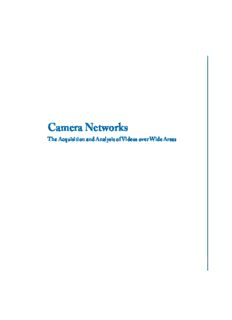
Camera Networks: The Acquisition and Analysis of Videos over Wide Areas PDF
Preview Camera Networks: The Acquisition and Analysis of Videos over Wide Areas
Camera Networks TheAcquisitionandAnalysisofVideosoverWideAreas Synthesis Lectures on Computer Vision Editors GérardMedioni,UniversityofSouthernCalifornia SvenDickinson,UniversityofToronto SynthesisLecturesonComputerVisioniseditedbyGérardMedionioftheUniversityof SouthernCaliforniaandSvenDickinsonoftheUniversityofToronto.Theserieswillpublish50- to150pagepublicationsontopicspertainingtocomputervisionandpatternrecognition.The scopewilllargelyfollowthepurviewofpremiercomputerscienceconferences,suchasICCV, CVPR,andECCV.Potentialtopicsinclude,butnotarelimitedto: (cid:129) ApplicationsandCaseStudiesforComputerVision (cid:129) Color,Illumination,andTexture (cid:129) ComputationalPhotographyandVideo (cid:129) EarlyandBiologically-inspiredVision (cid:129) FaceandGestureAnalysis (cid:129) IlluminationandReflectanceModeling (cid:129) Image-BasedModeling (cid:129) ImageandVideoRetrieval (cid:129) MedicalImageAnalysis (cid:129) MotionandTracking (cid:129) ObjectDetection,Recognition,andCategorization (cid:129) SegmentationandGrouping (cid:129) Sensors (cid:129) Shape-from-X iii (cid:129) StereoandStructurefromMotion (cid:129) ShapeRepresentationandMatching (cid:129) StatisticalMethodsandLearning (cid:129) PerformanceEvaluation (cid:129) VideoAnalysisandEventRecognition CameraNetworks:TheAcquisitionandAnalysisofVideosoverWideAreas AmitK.Roy-ChowdhuryandBiSong 2011 DeformableSurface3DReconstructionfromMonocularImages MathieuSalzmannandPascalFua 2010 Boosting-BasedFaceDetectionandAdaptation ChaZhangandZhengyouZhang 2010 Image-BasedModelingofPlantsandTrees SingBingKangandLongQuan 2009 Copyright© 2012byMorgan&Claypool Allrightsreserved.Nopartofthispublicationmaybereproduced,storedinaretrievalsystem,ortransmittedin anyformorbyanymeans—electronic,mechanical,photocopy,recording,oranyotherexceptforbriefquotationsin printedreviews,withoutthepriorpermissionofthepublisher. CameraNetworks:TheAcquisitionandAnalysisofVideosoverWideAreas AmitK.Roy-ChowdhuryandBiSong www.morganclaypool.com ISBN:9781608456741 paperback ISBN:9781608456758 ebook DOI10.2200/S00400ED1V01Y201201COV004 APublicationintheMorgan&ClaypoolPublishersseries SYNTHESISLECTURESONCOMPUTERVISION Lecture#4 SeriesEditors:GérardMedioni,UniversityofSouthernCalifornia SvenDickinson,UniversityofToronto SeriesISSN SynthesisLecturesonComputerVision Print2153-1056 Electronic2153-1064 Camera Networks TheAcquisitionandAnalysisofVideosoverWideAreas Amit K.Roy-Chowdhury and Bi Song UniversityofCalifornia,Riverside SYNTHESISLECTURESONCOMPUTERVISION#4 M &C Morgan &cLaypool publishers ABSTRACT Asnetworksofvideocamerasareinstalledinmanyapplicationslikesecurityandsurveillance,envi- ronmentalmonitoring,disasterresponse,andassistedlivingfacilities,amongothers,imageunder- standingincameranetworksisbecominganimportantareaofresearchandtechnologydevelopment. Therearemanychallengesthatneedtobeaddressedintheprocess.Someofthemarelistedbelow. -Traditionalcomputervisionchallengesintrackingandrecognition,robustnesstopose,illumina- tion,occlusion,clutter,recognitionofobjects,andactivities; -Aggregatinglocalinformationforwideareasceneunderstanding,likeobtainingstable,long-term tracksofobjects; - Positioning of the cameras and dynamic control of pan-tilt-zoom (PTZ) cameras for optimal sensing; -Distributedprocessingandsceneanalysisalgorithms; -Resourceconstraintsimposedbydifferentapplicationslikesecurityandsurveillance,environmental monitoring,disasterresponse,assistedlivingfacilities,etc. Inthisbook,wefocusonthebasicresearchproblemsincameranetworks,reviewthecurrent state-of-the-artandpresentadetaileddescriptionofsomeoftherecentlydevelopedmethodologies. The major underlying theme in all the work presented is to take a network-centric view whereby theoveralldecisionsaremadeatthenetworklevel.Thisissometimesachievedbyaccumulatingall thedataatacentralserver,whileatothertimesbyexchangingdecisionsmadebyindividualcameras basedontheirlocallysenseddata. Chapter1startswithanoverviewoftheproblemsincameranetworksandthemajorresearch directions. Some of the currently available experimental testbeds are also discussed here. One of thefundamentaltasksintheanalysisofdynamicscenesistotrackobjects.Sincecameranetworks cover a large area, the systems need to be able to track over such wide areas where there could bebothoverlappingandnon-overlappingfieldsofviewofthecameras,asaddressedinChapter2. Distributedprocessingisanotherchallengeincameranetworksandrecentmethodshaveshownhow todotracking,poseestimationandcalibrationinadistributedenvironment.Consensusalgorithms thatenablethesetasksaredescribedinChapter3.Chapter4summarizesafewapproachesonobject andactivityrecognitioninbothdistributedandcentralizedcameranetworkenvironments.Allthese methods have focused primarily on the analysis side given that images are being obtained by the cameras.Efficientutilizationofsuchnetworksoftencallsforactivesensing,wherebytheacquisition and analysis phases are closely linked.We discuss this issue in detail in Chapter 5 and show how collaborative and opportunistic sensing in a camera network can be achieved. Finally, Chapter 6 concludesthebookbyhighlightingthemajordirectionsforfutureresearch. KEYWORDS wideareatracking,distributedvideoanalysis,Kalmanconsensus,distributedtracking, recognition,activesensing,opportunisticsensing vii Amit:To my parents for all they have done Bi:To my parents ix Contents Preface .................................................................xiii 1 AnIntroductiontoCameraNetworks........................................1 1.1 Researchdirections ..................................................... 1 1.1.1 CameraNetworkTopology ........................................ 1 1.1.2 WideAreaTracking .............................................. 2 1.1.3 DistributedProcessing ............................................ 3 1.1.4 CameraNetworkControl(ACTIVEvision).......................... 4 1.1.5 MobileCameraNetworks ......................................... 5 1.1.6 SimulationinCameraNetworks .................................... 7 1.1.7 ExperimentalTestbeds ............................................ 7 1.1.8 ApplicationDomains ............................................. 8 1.2 Organizationofthebook ................................................ 9 2 Wide-AreaTracking ..................................................... 11 2.1 ReviewofMulti-TargetTrackingApproaches.............................. 11 2.1.1 KalmanFilter-BasedTracker...................................... 12 2.1.2 ParticleFilter-BasedTracker ...................................... 12 2.1.3 Multi-HypothesisTracking(MHT)................................ 13 2.1.4 JointProbabilisticDataAssociationFilters(JPDAF) ................. 14 2.2 TrackinginaCameraNetwork-ProblemFormulation...................... 14 2.3 AReviewonCameraNetworkTracking .................................. 16 2.4 On-LineLearningUsingAffinityModels................................. 17 2.5 TrackletAssociationUsingStochasticSearch .............................. 19 2.6 PersonReidentification ................................................. 24 2.7 LearningaCameraNetworkTopology ................................... 27 2.8 ConsistentLabelingwithOverlappingFieldsofView ...................... 29 2.9 Conclusions .......................................................... 31 3 DistributedProcessinginCameraNetworks................................ 33 3.1 ConsensusAlgorithmsforDistributedEstimation.......................... 33 x 3.2 DecentralizedandDistributedTracking................................... 35 3.2.1 DecentralizedTracking........................................... 35 3.2.2 DistributedTracking............................................. 36 3.3 ConsensusAlgorithmsforDistributedTracking............................ 36 3.3.1 MathematicalFramework ........................................ 36 3.3.2 ExtendedKalman-ConsensusFilterforaSingleTarget ............... 37 3.3.3 JPDA-EKCFforTrackingMultipleTargets ......................... 40 3.3.4 HandoffinConsensusTrackingAlgorithms......................... 44 3.3.5 ExampleofDistributedTrackingusingEKCF ....................... 44 3.3.6 SparseNetworksandNaiveNodes-TheGeneralizedKalman ConsensusFilter .................................................48 3.4 CameraNetworkCalibration............................................ 53 3.4.1 DistributedDataAssociation...................................... 53 3.4.2 DistributedCalibration........................................... 54 3.4.3 DistributedPoseEstimation ...................................... 56 3.5 Conclusions .......................................................... 57 4 ObjectandActivityRecognition .......................................... 59 4.1 ObjectRecognition .................................................... 59 4.1.1 ObjectRecognitionUnderResourceConstraints..................... 60 4.2 Time-DelayedCorrelationAnalysis ...................................... 61 4.2.1 SceneDecompositionandActivityRepresentation ................... 62 4.2.2 CrossCanonicalCorrelationAnalysis .............................. 63 4.2.3 Applications .................................................... 63 4.3 ActivityAnalysisUsingTopicModels .................................... 64 4.3.1 ProbabilisticModel .............................................. 65 4.3.2 LabelingTrajectoriesintoActivities ................................ 66 4.4 DistributedActivityRecognition......................................... 66 4.4.1 ConsensusforActivityRecognition ................................ 67 4.5 Conclusions .......................................................... 71 5 ActiveSensing .......................................................... 73 5.1 ProblemFormulation................................................... 73 5.1.1 ActiveSensingofDynamicalProcesses ............................. 74 5.2 ReviewofExistingApproaches .......................................... 77 5.3 CollaborativeSensinginDistributedCameraNetworks ..................... 78 5.3.1 SystemModeling................................................ 79
Description: